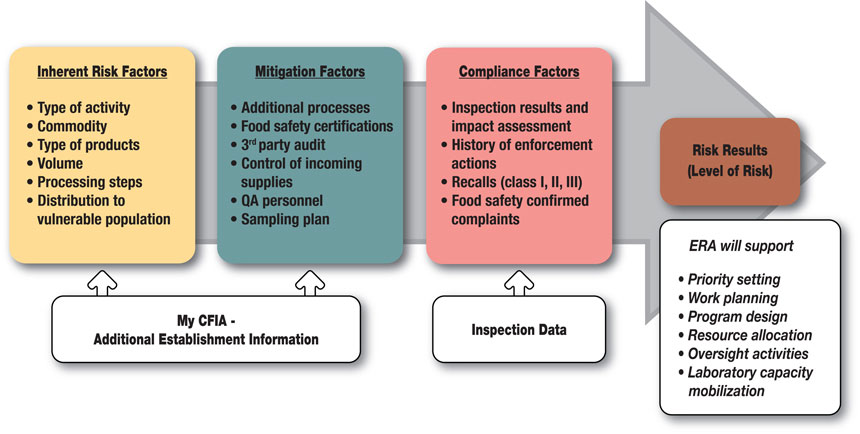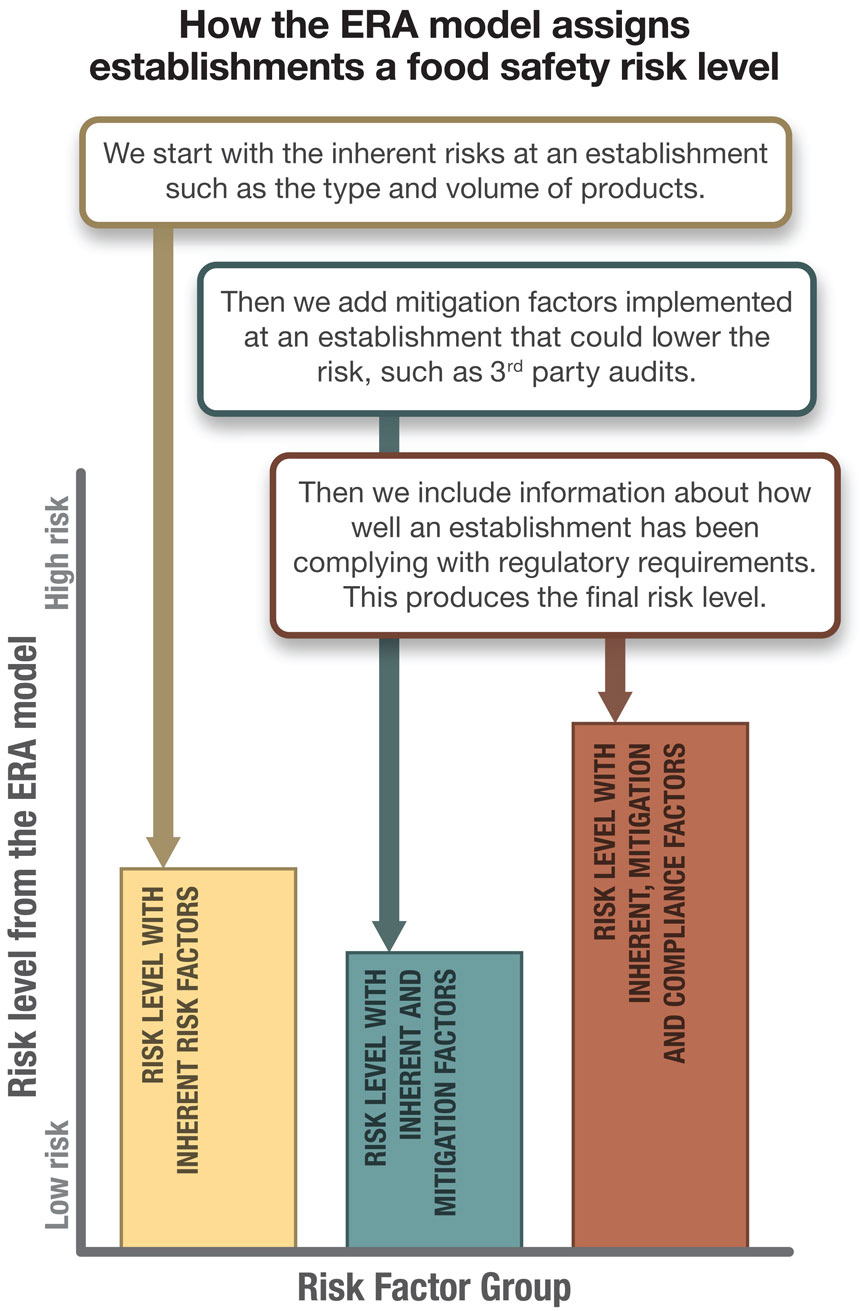Understanding the Establishment-based Risk Assessment Model for food establishments
The Canadian Food Inspection Agency (CFIA) is strongly committed to its mission to safeguard food, animals and plants to enhance the health and well-being of Canada's people, environment and economy.
Risks to food safety and our animal and plant resources have changed considerably in recent years and will continue to evolve rapidly with global trading patterns, innovation and new technology. In this fast-paced environment, the CFIA must continue to become more agile to help protect our resources while also supporting industry's ability to compete globally.
As part of the Agency's efforts to modernize its inspection system, the Establishment-based Risk Assessment (ERA-Food) model was developed to evaluate food establishments based on the level of risk they represent to consumers. The model uses data and a mathematical algorithm to determine the level of risk to inform oversight required by inspectors.
The CFIA worked together with academia, industry and government partners to create this tool to provide a consistent and efficient approach to inspection.
How the Establishment-based Risk Assessment model for food establishments works
The ERA-Food model identifies areas of higher risk and indicates where inspectors should be spending more time. Using scientific data, establishment-specific information gathered from regulated parties and the compliance history of an establishment, the ERA-Food model evaluates an establishment based on three different groups of risk factors and determines their level of risk (see image below). This means that higher risk establishments or sectors that require urgent attention can be easily identified and focused on.

Description for image – ERA-Food model arrow illustration
This figure illustrates the model design as an arrow. The ERA-Food model has three clusters: inherent risk factors, the mitigation factors, and the compliance factors represented by the first, second and third boxes, respectively. Each box presents the list of risk factors. The first two clusters are collected through My CFIA via the Additional Establishment Information and the last cluster is collected through inspection data. This then generates the final risk results (level of risk) that will support priority setting, work planning, program design, resource allocation, oversight activities and laboratory capacity mobilization.
The Implementation of the Establishment-based Risk Assessment model in federally regulated food establishments
Implementation of the ERA-Food model will impact the frequency and/or intensity of CFIA oversight. Establishments will be able to access their individual results and work with the CFIA on strategies to mitigate potential areas of concern.
The model is flexible to adapt to emerging and scientific trends in food safety and innovative practices that may be implemented at an establishment.

Description for image – How the ERA-Food model assigns establishments a food safety risk level
This figure depicts a graph with three bars representing the risk level from the ERA-Food model from low to high risk on the vertical axis. The first bar represents the risk level when considering the inherent risk factors such as the type of products and the volume. The second bar represents the risk level when considering the inherent risk factors combined with the mitigation factors such as third party audits. The last bar represents the final risk considering the inherent risk factors, mitigation factors and compliance factors. Compliance factors include information about how well the establishment has been complying with regulatory requirements.
Industry involvement in the Establishment-based Risk Assessment model for food establishments
Establishments are invited to provide information about their mitigation measures and operational activities by enrolling online to My CFIA and filling out the "Additional Establishment Information" questionnaire. The link can be accessed through an establishment's My CFIA account after it has received its Safe Food for Canadians (SFC) licence. An establishment will be prompted to provide this information when it renews or modifies its licence. Additionally, information can be updated any time it goes out of date by locating the tab in My CFIA. This information along with the compliance assessment of establishments will be used to populate the ERA-Food model and produce risk profiles for each food establishment.
Results from the ERA-Food model are being integrated in the Agency's work planning on a commodity by commodity basis.
Updates to the Establishment-based Risk Assessment model for food establishments
The CFIA will review and update the model on an ongoing basis, using the most up-to-date science, technology, and risk assessment approaches. It is designed to adapt quickly to emerging global and scientific trends, new risks and changes within establishments.
For questions or comments email: cfia.eramodel-modeleere.acia@inspection.gc.ca
Additional resources
- ERA-Food model: The science behind it
- Infographic: ERA-Food model
- Questions and answers: ERA-Food model
- Additional Establishment Information
- Industry eLearning on the ERA-Food model
- Date modified: